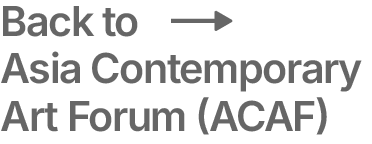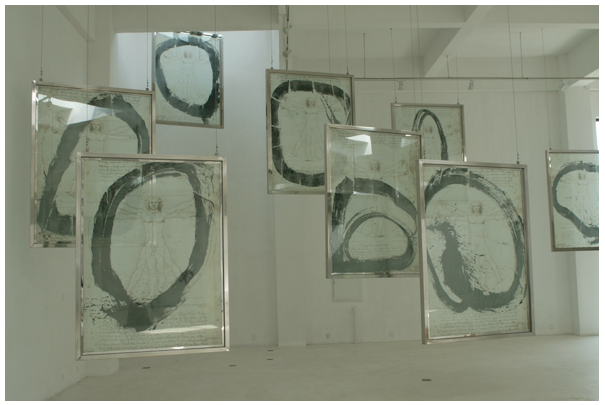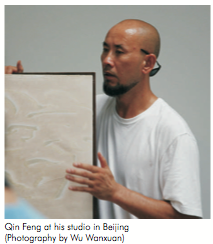Interview with Qin Feng
Qin Feng grew up as a shepherd in China’s Northwestern frontier region. His strong features and curly beard coupled with his dark tan and powerful build give him the air of a Chinese cowboy. Qin (b. 1961), recalls fondly that his first canvas was based on the open prairie, where he cut hay into square patches and peed circles into fresh snow. Qin left home in his early 20s and after living and working for eight years in Beijing and another eight years in Berlin, he eventually settled in Chelsea, a vibrant immigrant suburb of Boston. In recent years, he has returned to China regularly to work part-time in a studio on the outskirts of Beijing.
Qin Feng and his Civilization Landscape series (ink books) in 200
Despite the profound impact that these different places have had on him, his native Xinjiang has remained his prime source of inspiration. Literally the ‘new frontier’, Xinjiang is a province situated in the extreme northwest of China. Intersected by the once -bustling trade routes of the Silk Road, Xinjiang was historically a cosmopolitan center for cultures from Central Asia, the Eurasian steppes and China. Today, it is a unique part of China in which a dozen ethnicities coexist and both Chinese and Uighur are the official languages. Qin jokingly characterizes the milieu of his upbringing as a ‘bastardized culture’. He recalls growing up with neighbors of different ethnic origins and native tongues – Chinese, Uighur, Arabic, Russian – and that everyone could carry on a simple conversation in each of those languages.
This multilingual upbringing, followed by emigration to countries where he had to learn still other languages, instilled in the artist a fascination with both the spoken and the written word. With the stated goal of finding a personal system of signs that communicate universal ideas, Qin’s art records his investigations into questions of cultural difference as reflected in the misinterpretation of language.
Qin Feng’s work for the ‘Fresh Ink’ project is no exception. The cast inscription on the inner floor of the ancient bronze vessel triggered Qin’s attention and subsequent response. (Figs 1 and 1a). The inscription of four lines of 33 words is among the earliest-known Chinese texts. It narrates the commemorative occasion for which the vessel was cast, telling informing us that it was commissioned by a high minister in his father’s honor, and expressing the wish that it should be ‘forever treasured by sons and grand sons of future generations’.
Qin Feng’s solo show at the Beijing Museum of Contemporary Art, 2008.
Qin’s ambitious response to the vessel is a stadium-sized installation of energized brush work (Fig. 2). It is configured like a theatre, with a stage, a back drop, and an auditorium. In Qin’s words, the bronze takes center stage ‘as a speaker from the past’. A wall of thirteen floor-to-ceiling hanging scrolls forms the backdrop. Facing the stage, a fan-shaped stadium is composed of three wedge-shaped sections, each consisting of five rows of open books made of large sheets of accordion-folded paper wrapped in lamb skin at both ends (see illustration in Valerie Doran, ‘Behind the Scenes of “Fresh Ink”’, pp.).
Nevertheless, the installationis not complete without the viewer’s participation; one enters from the back row of books, walks down the aisles between them towards the stage, and finally comes face-to-face with the bronze. The encounter with the majestic ritual vessel is awe inspiring, but the real thrill of the experience is felt during the brief detours through the narrow lanes formed by the open books. Even in a crowded gallery, it is possible to find a private moment here, completely enveloped by a tangle of brush strokes and the unforgettable aroma of ink.
If the stage and its backdrop of vertical lines project a sense of order and solemnity, then the brushwork on the accordion books conveys chaotic exuberance and polyphonic ambiguity (Fig. 2a). This contrast is intentional as Qin sees the books as ‘active listeners’ to the declaration made by the bronze. The ‘monologue of history’, as he calls it, is projected from the bronze onto the books, where each page interprets the voice in its own way, reasserting the rich colors of individual experiences. This pseudo-ritualistic installation of fragmented writing opens new layers for interpretation and enlivens the potent symbolism of ancient bronzes, historically conveyed in writing and through ritual.
Qin’s intellectualization of the bronze does not obscure the emotive power of his work, which is embedded in autobiographical content. Sitting with the bronze in the Museam of Fine Arts’ basement storage, Qin was reminded of a shared alienation in which both were relocated to Boston and seperated from their respective cultural and historical contexts. (America is where Qin finally ‘lost his tongue’; of all the languages he speaks, he learned English last and considers it his weakest.) The installation presents a tangible sign of the artist’s desire to build a bridge connecting the piece to its place of origin.
Following that first encounter in the museum storage, Qin embarked on a pilgrimage to China where he visited various archaeological sites in search of the bronze’s origin. He collected earth at the sites, mixed them with a binding medium and applied the product to the hanging scrolls. In doing so, Qin symbolically reunited the bronze with its native place. Furthermore, the earth is both literally and figuratively the origin of the bronze, as fine-grained earth is the key material needed for bronze casting. The integrated smell of earth further enriches the play on the “unearthed bronze.” Qin explains, ‘I could not have completed this project in America, though I formed its concept there. I had to return to China to re-experience the web of connections between the earth that produced the bronze and the transplanted bronze in Boston.’
While Qin Feng’s installation exposes the bronze, it also provides an intimate view of the artist, and actively engages the audience. His innovative work with the bronze provides an alternative mode of experiencing art beyond the bounds of the traditional museum. The installation encourages personal and direct engagement with an ancient work of art from a culture that is potentially unfamiliar to viewers. Through this work, Qin says he is ‘promoting an attitude of accommodation towards our shared cultural heritages, to accept hybridity, and to validate personal responses to works of art’.
Hao Sheng is the Wu Tung Curator of Chinese Art at the Museum of Fine Arts, Boston.
A sculpture installation Qin Feng did in 2008 for Beijing Museum of Contemporary Art
Orientations: How would you sum up your installation for the ‘Fresh Ink’ project? How does it fit into your overall body of work?
Qin Feng: Actually, I see this piece as a kind of coincidence. I began a large-scale series of installation works called ‘Civilization Landscape’ 10 years ago. The works in this series took the form of enlarged accordion-style books, which I painted with symbols from ancient civilizations. I wanted to remove the cultural specificity of these painted symbols, so I began to break them down into their primary marks, using the most basic
materials of brush, ink, and paper. This was my way of describing our common past. The work for the Boston exhibition is really the conclusion of this series.
Of course, I had to change a few things for this exhibition; most importantly, the focus of this installation is a colossal early bronze, just a single object. I selected this ancient relic because it has the power to communicate history without using words.
Like an actor, the bronze takes centre stage in my installation, and then my own works are positioned behind it, thirteen hanging scrolls that form the backdrop. This theatre-like setting allows the audience to experience the communication between the background and foreground, to feel the universal energy of the object. It is the completion of the comparison that finalizes my Civilization Landscape series.
I feel that this work is fundamentally tied to my previous works on culture and civilization. Over the course of 30 years, my work has covered nearly all the elements and styles of culture. Even during my time at university, I was more concerned with the topic of civilization than with art per se. Thus, this topic should be considered my creative career’s primary focus.
O: From an ancient bronze vessel to a multi-faceted calligraphic installation: what is the significance of the medium?
QF: Since the 1980s, I have been continually researching and experimenting with new ink painting and contemporary ink painting, and it has taken various creative trials to finally reach the level I work at today. My creative method and expression utilize primarily the language of ink and brush. That is to say, sometimes I depart from using ink and brush, but the language I am using is still the same.
Even with oil painting, acrylic painting and Western painting, I still use Eastern elements to show off the expression of ink painting; only here, my task is to improve upon ink painting’s traditional sense via the material and mode of expression.
O: What is it that draws you to working in the medium of brush and ink on paper?
QF: Personally, I think it is more important to look at the language of one’s art than the medium and the method. The materials that I employ in my artistic process don’t have much in common with traditional brush and ink on paper. My art is more of an attempt to harmoniously blend Eastern and Western elements and artistic media together than to limit myself and select one technique over another.
O: How did you feel when you returned to China to visit sites where the bronze may have been created?
QF: This research has a coincidental aspect, too. When I was at school, one of my courses examined Han dynasty culture, and we looked at bronze ware, bronze script, oracle bone inscriptions, and so on. At that time, my research was still relatively juvenile, but my basic topic of study was already the culture of the Yellow River basin as the birthplace of bronze ware. It is gratifying to come back to this topic now, 20 or 30 years after I first conducted an investigation of this area.
O: Growing up in the wild open spaces of Xinjiang, what were your dreams and ambitions? Have you fulfilled them?
QF: During my childhood, I had a dream: to venture to the end of the grassland. Of course, the grassland is extremely big; if you journey far, you aren’t able to return easily, which is why I never dared to walk beyond where my eyes could see.
When your vision is controlled by this kind of environment, it is completely stifling, so from early on, I had this desire: I hoped the day would come when I could go in the opposite direction, not necessarily to far-off places, but to do things and visit places that I have never seen before.
Of course, I found this to be much more difficult than I had expected! I had to change the way I had been brought up to think, and learn to really experience the whole process of life. I think that was the goal of my first artistic performance pieces… I’m someone who is easily satisfied. So yes, I have to say that my childhood desire was achieved!
O: Who or what has been your greatest inspiration?
QF: I think my life’s greatest inspiration consists of the brutal moments I experienced during my earliest years. My great grandfather’s exile in Xinjiang and my family’s experience of being harshly persecuted during the Cultural Revolution instilled in me the importance of moving forward and making sure not to let myself regress and fall backwards.
O: What message do you hope to convey through your calligraphy?
QF: As you go through life, calligraphy is simply a way of expressing the soul.
O: You have held successful exhibitions in many locations around the world. How do different audiences relate to your work?
QF: This is an interesting question. One time, when I was in Europe for an exhibition, I was a little astonished to find Westerners saying that my work looked like the face of someone who is mixed-race: it feels very familiar but is not exactly the same as European art. They said they saw a kind of Western painting in its form, language and mood, but that my material was very Chinese.
Chinese people, on the other hand, often do not appreciate this mixture. Sometimes, I feel that Chinese people are very conservative, and reluctant to admit that things change, because they do not want to change for fear of getting crowded out. I think Westerners are the opposite. However, they have a tendency to look at Asian art culture and think of it as being normative. Labels such as ‘Eastern origin’ or ‘Ancient Chinese sentiment’ influence contemporary art with a kind of inertia. These are some of the important aesthetic issues that are raised by different audiences.
O: What are your views on the recent attention and scholarship focusing on Chinese contemporary art?
QF: From a historical perspective, there have always been ups and downs in Chinese art, but for a long time, there was a stagnation of research in this field. When China opened up, and there were more visible artists and artist communities, the world started enthusiastically embracing Chinese art, as if it were a fashion trend. I think this is not a very responsible approach to art, and it has lasting effects on the artists themselves. I feel that many so-called contemporary Chinese paintings are actually very market driven, artists work with subjects that they know sell well. Further more, many Asian artists are currently copying the last 50 years of Western art – it’s the same thing, but with a different face.
Interview conducted and translated by Tiffany Beres.
The interview is first published in the October 2010 issue of Orientations.






